Understanding Quran Memorization Patterns: Insights from User Data

Date: 29 July 2025
Md. Ashraful Haque | GTAF R&D
At Greentech Apps Foundation (GTAF), our mission is to bring people closer to Allah ﷻ through technology that supports traditional Islamic learning. One of our most beloved tools, the Quran Memoriser app, helps users across the globe on their journey to memorise the Book of Allah.
In this article, we share insights from real user data that reveal how people approach Quran memorisation in the digital age — what Surahs they start with, where they pause, and which chapters receive special attention. These findings not only reflect user behaviour but also reaffirm how deeply rooted Islamic tradition continues to guide memorisation practices today.
The Journey Through Surahs: User Progress Visualization
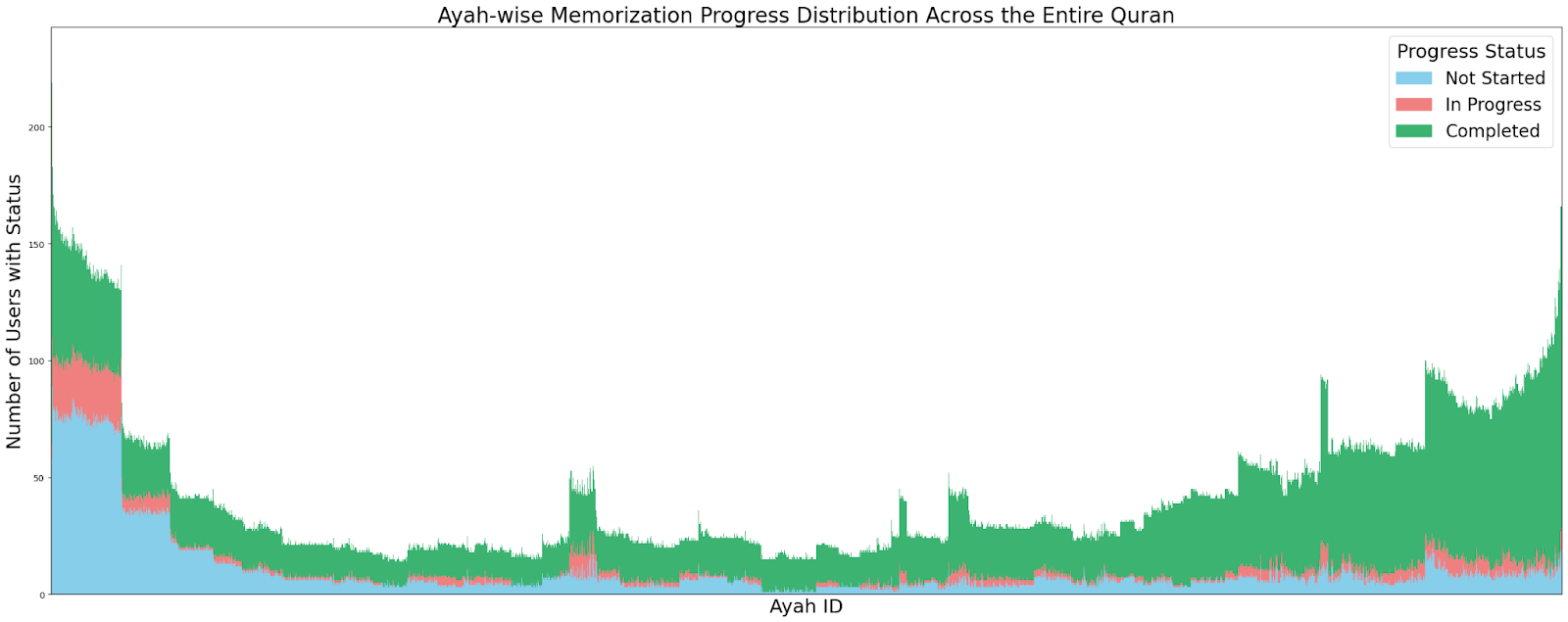
Our visualization charts track users’ memorization progress across all 114 Surahs of the Quran, categorized into three statuses: “Not Started,” “In Progress,” and “Completed.” These visualizations provide remarkable insights into collective memorization behaviors.
Front-Loading Phenomenon: The Early Surahs
One of the most striking patterns in our data is what we might call the “front-loading” phenomenon. The charts clearly show that Surahs 1-2 (Al-Fatiha and Al-Baqarah) have the highest number of users with “Completed” status. This makes perfect sense from an Islamic practice perspective – Surah Al-Fatiha is recited in every unit of the five daily prayers and is considered the “Opening” of the Quran, containing profound theological concepts despite its brevity.
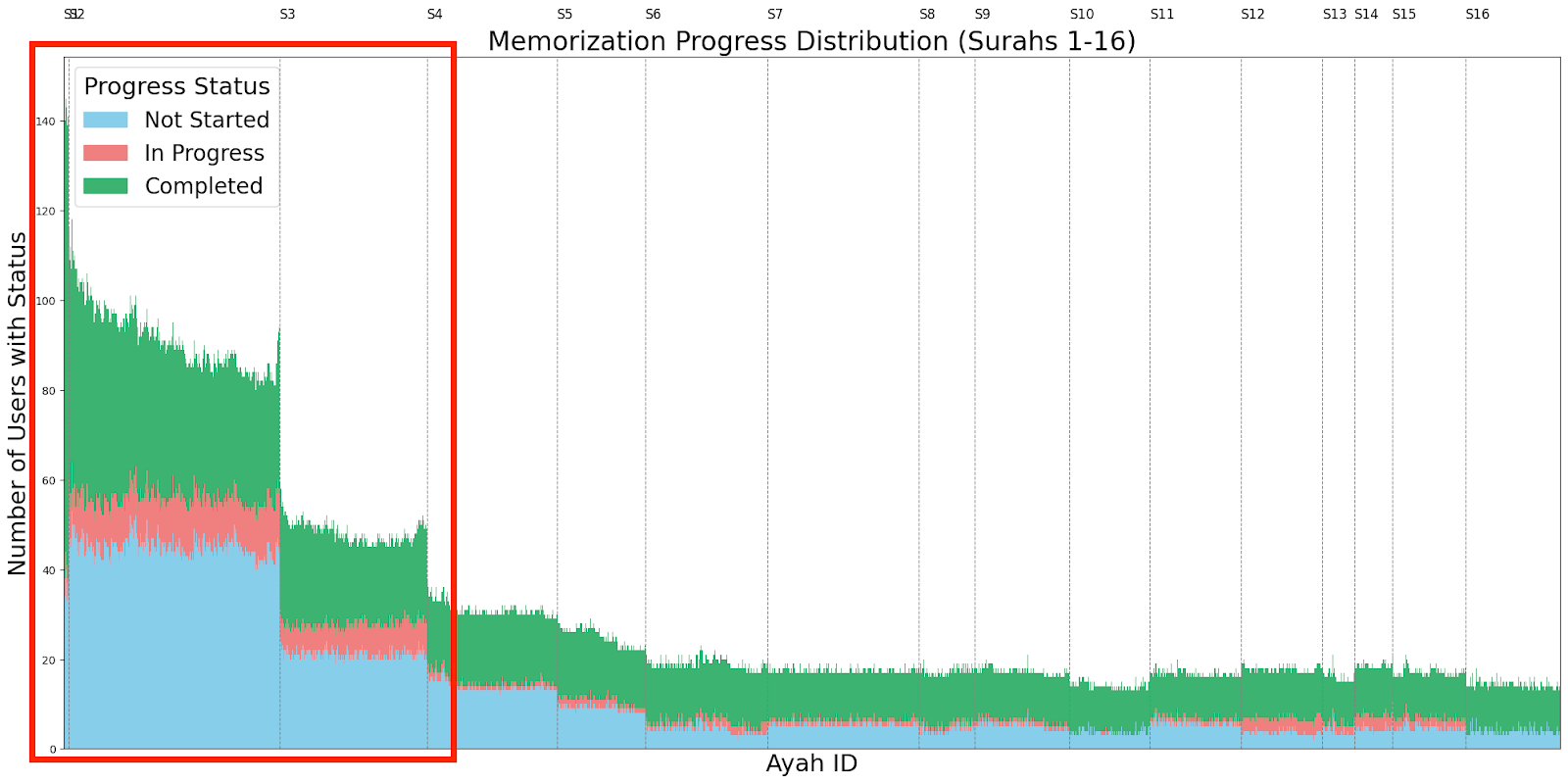
The data shows a steep decline in completion rates after Surah 2 (Al-Baqarah), with a gradual tapering pattern as users progress through the Quran. This mirrors traditional memorization approaches, where beginners typically start with Al-Fatiha and then proceed to shorter Surahs or those with special significance.
The Last Verses of Al-Baqarah and Al-Imran: Special Significance
Our data shows particularly high completion rates for the last verses of Surah Al-Baqarah (2) and Surah Al-Imran (3). This aligns perfectly with Islamic traditions emphasizing their importance.
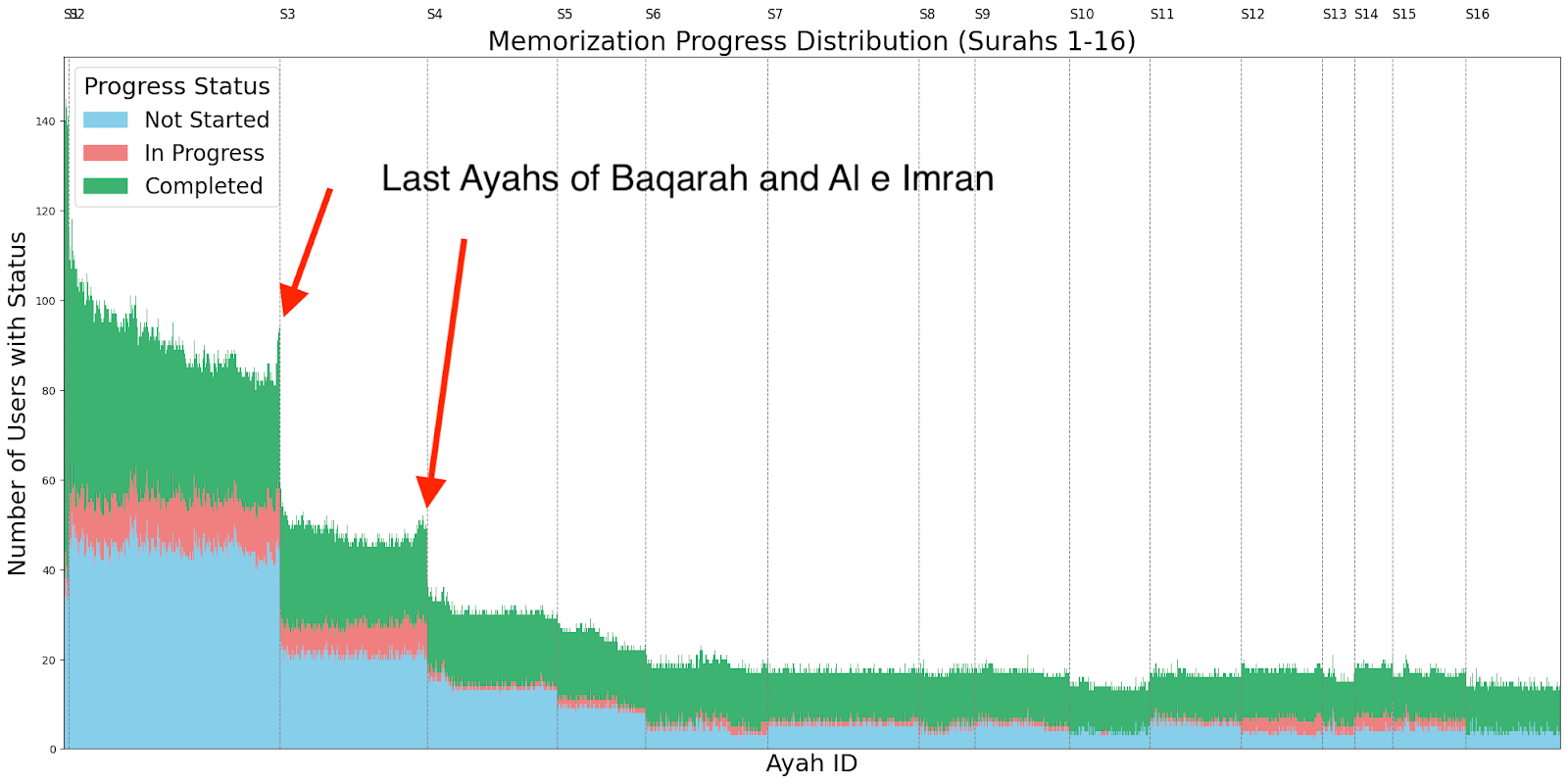
The last two verses of Surah Al-Baqarah (verses 285-286) hold exceptional status in Islamic tradition. According to authentic narrations, these verses were given to Prophet Muhammad (PBUH) during the Night Journey (Isra and Mi’raj) as a special gift. The Prophet mentioned, “Whoever recites the last two verses of Surah Al-Baqarah at night, it will suffice him” (Sahih Bukhari). These verses contain profound supplications asking for Allah’s mercy and protection, acknowledging human limitations, and seeking forgiveness.
Similarly, the last ten verses of Surah Al-Imran (verses 190-200) show higher completion rates in our data. The Prophet Muhammad (PBUH) was known to recite these verses in the night for prayers. These verses emphasize reflection on the creation of the heavens and earth, and contain beautiful supplications for protection and guidance.
The high completion rates for these specific sections in our user data demonstrate how digital memorization practices are preserving traditional Islamic priorities.
Middle Surah Challenges: The Valley Effect

Our data reveals what we might call a “valley effect” in the middle Surahs (approximately Surahs 10-50), where completion rates are significantly lower compared to both the beginning and end of the Quran. This may reflect several factors:
- These middle Surahs are often longer and more complex
- Users tend to prioritize memorizing Surahs with special virtues mentioned in Hadith
- The enthusiasm of beginning a memorization journey may wane in the middle sections
Standout Surahs: Peaks in the Data
Several notable “peaks” appear in our visualization where certain Surahs show significantly higher completion rates than those surrounding them:
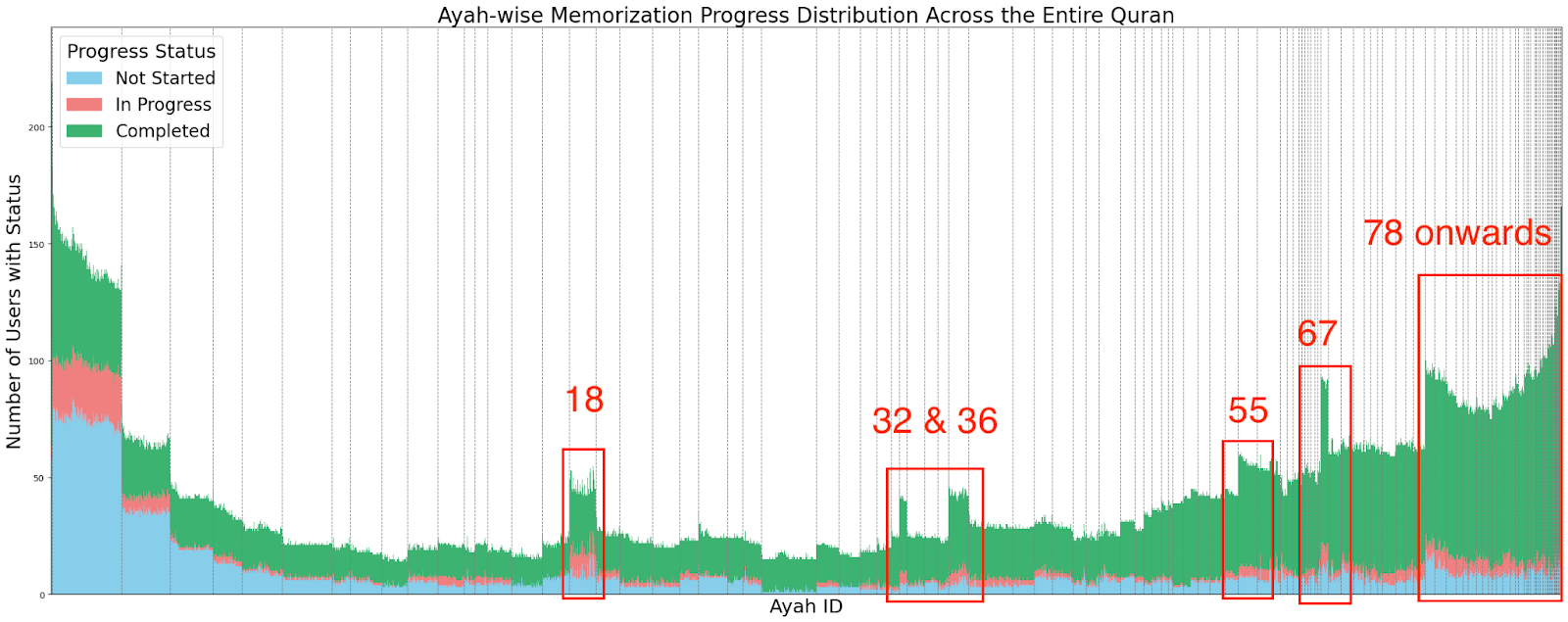
Surah Al-Kahf (18): The Cave Chapter’s Special Status
Our data visualization reveals an interesting spike in completion rates for Surah Al-Kahf (18), which stands out compared to surrounding Surahs. This pattern is particularly noteworthy given the special significance of this chapter in Islamic tradition.
Surah Al-Kahf is known as “The Cave” and contains 110 verses filled with four main stories that offer profound spiritual lessons. It holds a unique place in Islamic practice as the Surah recommended for recitation every Friday. According to authentic Hadith, the Prophet Muhammad (PBUH) said: “Whoever reads Surah Al-Kahf on Friday, a light will shine for him between the two Fridays” (Al-Bayhaqi and Al-Hakim).
Beyond its weekly recitation benefits, Surah Al-Kahf is also associated with protection from the trials of Dajjal (the Antichrist). The Prophet (PBUH) stated: “Whoever memorizes the first ten verses of Surah Al-Kahf will be protected from the Dajjal” (Sahih Muslim). This spiritual protection is highly valued in Islamic tradition.
The prominence of this Surah in our user data demonstrates how app users are prioritizing chapters with specific spiritual benefits mentioned in Hadith. The higher completion rate for Surah Al-Kahf compared to surrounding chapters suggests users are specifically targeting it for memorization, likely due to both its weekly recitation practice and its protective benefits.
Surah As-Sajdah (32): The Prostration Chapter
Another notable spike in our visualization occurs at Surah As-Sajdah (32), also known as “The Prostration.” This chapter holds special significance in Islamic tradition, particularly for nighttime worship. According to authentic narrations, the Prophet Muhammad (PBUH) would regularly recite Surah As-Sajdah along with Surah Al-Mulk before sleeping.
This Surah is one of only four chapters in the Quran that contain an obligatory prostration (sajdah), which occurs at verse 15. When Muslims recite or hear this verse, they are required to perform a prostration, making it particularly memorable and impactful. The Surah addresses fundamental Islamic beliefs including monotheism (Tawhid), prophethood (Risalah), and the afterlife (Akhirah).
The high completion rate for this Surah in our data suggests that many users are following the Prophet’s sunnah (practice) of reciting it before sleep, and are prioritizing memorization of chapters with obligatory prostrations. It’s a beautiful example of how traditional Islamic practices are being maintained through digital means.
Surah Yasin (36): The Heart of the Quran
Surah Yasin shows a distinct spike in completion rates compared to neighboring Surahs. Often called the “Heart of the Quran,” this Surah is particularly revered in Islamic tradition. The Prophet Muhammad (PBUH) is reported to have said that reciting Surah Yasin would reward the reader as if they had recited the entire Quran ten times (authenticity may be disputed). Our data suggests users are specifically targeting this Surah for memorization, likely due to its spiritual significance.
Surah Ar-Rahman (55): The Most Compassionate
Another clear peak appears for Surah Ar-Rahman. Known for its beautiful rhythmic pattern and repeated verse “So which of the favors of your Lord would you deny?”, this Surah is often recommended as one of the first to memorize due to its poetic repetition that aids memorization. The data confirms users are following this traditional advice.
Surah Al-Mulk (67): The Protector
Surah Al-Mulk shows another notable spike in completion rates. According to Hadith, this Surah serves as an intercessor and protector for those who recite it regularly, particularly before sleep. Our user data indicates this traditional practice is being maintained through digital means.
Surah An-Naba (78): The Great News
The visualization shows a distinct spike at Surah An-Naba (78), which marks the beginning of Juz Amma (the 30th and final part of the Quran). This Surah, whose title means “The Great News,” focuses on the Day of Resurrection and addresses those who doubt this reality.
In Islamic tradition, this Surah holds special importance as it opens the final section of the Quran that many Muslims start their memorization journey with. According to authentic narrations, the Prophet Muhammad (PBUH) mentioned this Surah among those that “made him gray-haired” due to their powerful descriptions of the Day of Judgment.
The high completion rate for this Surah in our data demonstrates how users are following traditional Islamic memorization patterns, starting with the beginning of Juz Amma and working through these shorter, more accessible chapters. This spike represents a significant threshold in Quran memorization practice, where many users transition from the longer, more complex middle Surahs to the shorter, more frequently recited final Surahs.
The Final Quarter Resurgence
Interestingly, we observe a significant uptick in completion rates for Surahs in the final quarter of the Quran (approximately Surahs 78-114). This “final quarter resurgence” shows that many users have successfully memorized these shorter Surahs. This pattern aligns with traditional teaching methods that recommend beginners start with these shorter, more frequently recited Surahs found at the end of the Quran.
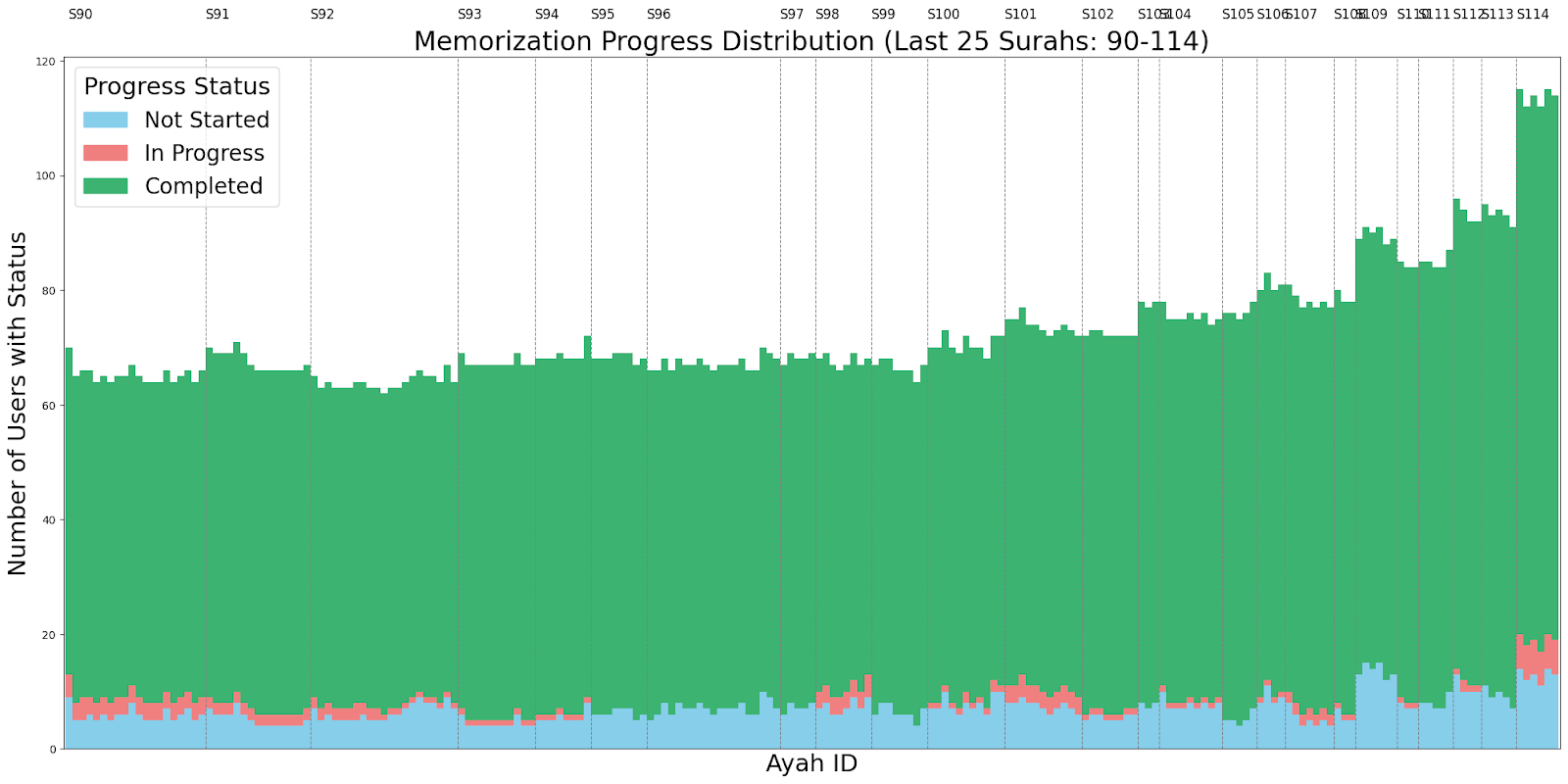
The data shows particularly high completion rates for Surahs like Al-Ikhlas (112), Al-Falaq (113), and An-Nas (114) – collectively known as the “Three Quls,” which hold special protective benefits according to Hadith and are commonly taught to children at an early age.
Understanding the “In Progress” Status
The “In Progress” status (shown in pink in our visualizations) provides unique insights into current memorization efforts. We notice:
- Longer Surahs tend to have more users in the “In Progress” state for extended periods
- The beginning Surahs (1-10) show the highest percentage of users actively memorizing
- There’s a correlation between traditional Islamic calendar events (like Ramadan) and increases in “In Progress” status for specific Surahs
Practical Implications for Memorization
Our data offers valuable insights for anyone on a Quran memorization journey:
- Start with the most frequently used Surahs: The data validates the traditional approach of beginning with Al-Fatiha and the shorter Surahs from the final Juz (part).
- Don’t neglect the middle: The “valley effect” suggests many users struggle with middle Surahs. Creating specific goals and breaking these longer Surahs into manageable portions could help overcome this challenge.
- Leverage repetition patterns: Surahs with natural repetition (like Ar-Rahman) show higher completion rates, suggesting that focusing on these can build confidence and momentum.
- Follow tradition with technology: The data shows that traditional Islamic memorization priorities are reflected in digital usage patterns. Users are focusing on Surahs with special virtues mentioned in Hadith.
Conclusion: The Digital Transformation of Sacred Practice
Our data shows that Muslims today are not abandoning tradition — they’re embracing it with the help of technology. The memorisation patterns reflect timeless priorities passed down through generations, now supported by modern tools.
At Greentech Apps Foundation, we’re honoured to be part of this journey. Every feature we build is designed to support sincere efforts to memorise the Quran — from the first verse to the last.
We’re excited to use these insights to improve our app and make memorisation even more accessible, especially for beginners, students, and busy Muslims around the world.
🤝 We’d Love Your Feedback
This research is part of our broader commitment to Islamic learning through digital innovation.
If you’re a teacher, scholar, student, or app user, your insights can help us do better.
📬 Email: contact@gtaf.org
🌐 Visit: gtaf.org
📱 Try the Quran Memoriser app today
🔍 For more research insights: gtaf.org/blog/category/research
Let us know how we can serve you better — and may Allah place barakah in every verse you memorise.
– The Greentech Apps Foundation Team


